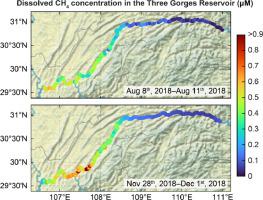Water Research ( IF 11.4 ) Pub Date : 2021-10-21 , DOI: 10.1016/j.watres.2021.117788 Jia Liu 1 , Shangbin Xiao 1 , Chenghao Wang 2 , Zhengjian Yang 1 , Defu Liu 3 , Xiaojuan Guo 1 , Liu Liu 4 , Andreas Lorke 5

|
Methane (CH4) emissions from freshwater aquatic systems such as rivers and reservoirs are an important component of the global methane budget. However, the estimation can be largely affected by the spatial and temporal resolutions of measurements. Especially, the lack of high-resolution studies in the Three Gorges Reservoir (TGR), one of the largest reservoirs in the world, has led to a longstanding debate on its CH4 emissions. In this study, the spatial distribution and seasonal variations of dissolved CH4 concentrations were measured using a fast-response automated gas equilibrator in the TGR. We observed large spatiotemporal variations of dissolved CH4 (mean ± SD: 0.26 ± 0.19 μM in summer and 0.24 ± 0.17 μM in winter). Higher concentrations with stronger variations were found in the upstream than in the section close to the Three Gorges Dam. The dissolved CH4 concentration in the TGR was mainly influenced by sewage discharge, sedimentation, topographical conditions, tributaries, and spatial and seasonal variations in hydrodynamics. Regression analyses suggest that the concentration can be characterized by sewage discharge, water depth, and electrical conductivity to a certain extent. Mean diffusive CH4 fluxes from the TGR in summer and winter were 16.2 mg m−2 d−1 and 3.1 mg m−2 d−1, respectively. Downsampling simulations show that scaling dissolved CH4 in the TGR from one site likely involves large errors, and at least ∼38 sites and ∼52–58 sites are needed to achieve an accurate estimate in summer and winter, respectively. Due to the large spatial and temporal heterogeneity, high-resolution measurements are key to improving the reliability of CH4 estimates and assessing the contribution of the TGR to regional and global CH4 budgets.
中文翻译:

三峡水库溶解甲烷浓度和扩散排放的时空变化
来自河流和水库等淡水水生系统的甲烷 (CH 4 ) 排放是全球甲烷预算的重要组成部分。然而,估计在很大程度上受测量的空间和时间分辨率的影响。特别是,世界上最大的水库之一三峡水库 (TGR) 缺乏高分辨率研究,导致对其 CH 4排放的长期争论。在本研究中,使用 TGR 中的快速响应自动气体平衡器测量了溶解 CH 4浓度的空间分布和季节性变化。我们观察到溶解 CH 4 的巨大时空变化(平均值±标准差:夏季为 0.26 ± 0.19 μM,冬季为 0.24 ± 0.17 μM)。与靠近三峡大坝的部分相比,上游发现了更高的浓度和更强的变化。TGR中溶解的CH 4浓度主要受污水排放、沉积、地形条件、支流以及水动力空间和季节变化的影响。回归分析表明,该浓度在一定程度上可以通过污水排放、水深和电导率来表征。夏季和冬季来自 TGR 的平均扩散 CH 4通量分别为 16.2 mg m - 2 d - 1和 3.1 mg m - 2 d - 1, 分别。下采样模拟表明,从一个站点按比例缩放TGR 中溶解的 CH 4可能涉及很大的误差,并且至少需要约 38 个站点和约 52-58 个站点才能分别在夏季和冬季实现准确估计。由于巨大的空间和时间异质性,高分辨率测量是提高 CH 4估计的可靠性和评估 TGR 对区域和全球 CH 4预算贡献的关键。











































 京公网安备 11010802027423号
京公网安备 11010802027423号